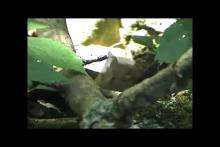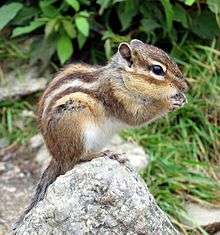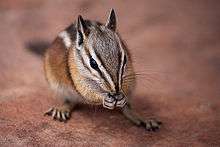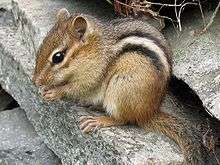Chipmunk
| Chipmunk Temporal range: Early Miocene to Recent | |
|---|---|
 | |
| Least chipmunk | |
| Scientific classification | |
| Kingdom: | Animalia |
| Phylum: | Chordata |
| Class: | Mammalia |
| Order: | Rodentia |
| Suborder: | Sciuromorpha |
| Family: | Sciuridae |
| Tribe: | Marmotini |
| Subtribe: | Tamiina |
| Genus: | Tamias Illiger, 1811 |
| Subgenera | |
|
3, see text | |
Chipmunks are small, striped rodents of the family Sciuridae. Chipmunks are found in North America, with the exception of the Siberian chipmunk which is found primarily in Asia.
Taxonomy and systematics
Chipmunks may be classified either as a single genus, Tamias (Greek: ταμίας), or as three genera: Tamias, which includes the eastern chipmunk; Eutamias, which includes the Siberian chipmunk; and Neotamias, which includes the 23 remaining, mostly western, species. These classifications are arbitrary, and most taxonomies over the twentieth century have placed the chipmunks in a single genus. However, studies of mitochondrial DNA show that the divergence between each of the three chipmunk groups is comparable to the genetic dissimilarity between Marmota and Spermophilus.[1][2][3][4]
The genus name Tamias is Greek for "treasurer", "steward", or "housekeeper",[5] which is a reference to the animals' role in plant dispersal through their habit of collecting and storing food for winter use.[6]
The common name originally may have been spelled "chitmunk," from the native Odawa (Ottawa) word jidmoonh, meaning "red squirrel" (cf. Ojibwe, ajidamoo).[7][8] The earliest form cited in the Oxford English Dictionary (from 1842) is "chipmonk," however, "chipmunk" appears in several books from the 1820s and 1830s.[9] Other early forms include "chipmuck" and "chipminck," and in the 1830s they were also referred to as "chip squirrels;" probably in reference to the sound they make. In the mid-1800s, John James Audubon and his sons included a lithograph of the chipmunk in their Viviparous Quadrupeds of North America, calling it the "chipping squirrel [or] hackee."[10] Chipmunks have also been referred to as "striped squirrels," "chippers," "munks," "timber tigers," and "ground squirrels" (although the name "ground squirrel" usually refers to other squirrels, such as those of the genus Spermophilus).
Diet

Chipmunks have an omnivorous diet primarily consisting of seeds, nuts and other fruits, and buds.[11][12] They also commonly eat grass, shoots, and many other forms of plant matter, as well as fungi, insects and other arthropods, small frogs, worms, and bird eggs.[11][12][13][14][15][16] Around humans, chipmunks can eat cultivated grains and vegetables, and other plants from farms and gardens, so they are sometimes considered pests.[11][17] Chipmunks mostly forage on the ground, but they climb trees to obtain nuts such as hazelnuts and acorns.[11][18] At the beginning of autumn, many species of chipmunk begin to stockpile nonperishable foods for winter. They mostly cache their foods in a larder in their burrows and remain in their nests until spring, unlike some other species which make many small caches of food.[11] Cheek pouches allow chipmunks to carry food items to their burrows for either storage or consumption.[12]
Ecology and life history

.jpg)
Eastern chipmunks mate in early spring and again in early summer, producing litters of four or five young twice each year.[11] Western chipmunks breed only once a year. The young emerge from the burrow after about six weeks and strike out on their own within the next two weeks.[19]
These small mammals fulfill several important functions in forest ecosystems. Their activities harvesting and hoarding tree seeds play a crucial role in seedling establishment. They consume many different kinds of fungi, including those involved in symbiotic mycorrhizal associations with trees, and are an important vector for dispersal of the spores of subterranean sporocarps (truffles) which have co-evolved with these and other mycophagous mammals and thus lost the ability to disperse their spores through the air.[20]
Chipmunks construct expansive burrows which can be more than 3.5 m (11 ft) in length with several well-concealed entrances.[21] The sleeping quarters are kept clean as shells and feces are stored in refuse tunnels.[22]
The eastern chipmunk hibernates in the winter, while western chipmunks do not, relying on the stores in their burrows.[23]
Chipmunks play an important role as prey for various predatory mammals and birds but are also opportunistic predators themselves, particularly with regard to bird eggs and nestlings. In Oregon, mountain bluebirds (Siala currucoides) have been observed energetically mobbing chipmunks that they see near their nest trees.
Chipmunks typically live about three years although some have been observed living to nine years in captivity.[24]
Chipmunks in captivity are said to sleep for an average of about 15 hours a day. It is thought that mammals which can sleep in hiding, such as rodents and bats, tend to sleep longer than those that must remain on alert.[25]
Species
Subgenus Eutamias
- Siberian chipmunk, Eutamias sibiricus
- Eastern chipmunk, Tamias striatus
Subgenus Neotamias
- Allen's chipmunk, Neotamias senex
- Alpine chipmunk, Neotamias alpinus
- Buller's chipmunk, Neotamias bulleri
- California chipmunk, Neotamias obscurus
- Cliff chipmunk, Neotamias dorsalis
- Colorado chipmunk, Neotamias quadrivittatus
- Durango chipmunk, Neotamias durangae
- Gray-collared chipmunk, Neotamias cinereicollis
- Gray-footed chipmunk, Neotamias canipes
- Hopi chipmunk, Neotamias rufus
- Least chipmunk, Neotamias minimus
- Lodgepole chipmunk, Neotamias speciosus
- Long-eared chipmunk, Neotamias quadrimaculatus
- Palmer's chipmunk, Neotamias palmeri
- Panamint chipmunk, Neotamias panamintinus
- Merriam's chipmunk, Neotamias merriami
- Red-tailed chipmunk, Neotamias ruficaudus
- Siskiyou chipmunk, Neotamias siskiyou
- Sonoma chipmunk, Neotamias sonomae
- Townsend's chipmunk, Neotamias townsendii
- Uinta chipmunk, Neotamias umbrinus
- Yellow-cheeked chipmunk, Neotamias ochrogenys
- Yellow-pine chipmunk, Neotamias amoenus
Extinct:
- †Tamias aristus
See also
References
- ↑ Wilson, D. E.; D. M. Reeder (2005). "Mammal Species of the World". Archived from the original on 2007-06-23. Retrieved 2007-06-27.
- ↑ Piaggio, A. J.; Spicer, G. S. (2001). "Molecular phylogeny of the chipmunks inferred from mitochondrial cytochrome b and cytochrome oxidase II gene sequences" (PDF). Molecular Phylogenetics and Evolution. 20 (3): 335–350. doi:10.1006/mpev.2001.0975. PMID 11527462.
- ↑ Piaggio, Antoinette J.; Spicer, Greg S. (2000). "Molecular Phylogeny of the Chipmunk Genus Tamias Based on the Mitochondrial Cytochrome Oxidase Subunit II Gene" (PDF). Journal of Mammalian Evolution. 7 (3): 147–166. doi:10.1023/a:1009484302799.
- ↑ Musser, G. G.; Durden, L. A.; Holden, M. E.; Light, J. E. (2010). "Systematic review of endemic Sulawesi squirrels (Rodentia, Sciuridae), with descriptions of new species of associated sucking lice (Insecta, Anoplura), and phylogenetic and zoogeographic assessments of sciurid lice". Bulletin of the American Museum of Natural History (339).
- ↑ Henry George Liddell; Robert Scott. (1940). A Greek-English Lexicon, revised and augmented throughout by Sir Henry Stuart Jones with the assistance of Roderick McKenzie. Oxford: Clarendon Press.
- ↑ Snyder, D.P. (1982). "Tamias striatus": 1–8. JSTOR 3503819.
- ↑ "Online Etymology Dictionary". Etymonline.com. Retrieved 2012-12-07.
- ↑ Nichols, John D. and Earl Nyholm (1995). A Concise Dictionary of Minnesota Ojibwe. Minneapolis: University of Minnesota Press.
- ↑ "Google Books". Google.com. Retrieved 2012-12-07.
- ↑ Audubon, John James; Bachman, John (1967). Imperial Collection of Audubon Mammals. New York: Bonanza Books, a division of Crown Publishing Group. p. 52.
- 1 2 3 4 5 6 Hazard, Evan B. (1982). The Mammals of Minnesota. University of Minnesota Press. pp. 52–54. ISBN 0-8166-0952-7.
- 1 2 3 "West Virginia Wildlife Magazine: Wildlife Diversity Notebook. Eastern chipmunk". Wvdnr.gov. Retrieved 2012-12-07.
- ↑ "Eastern Chipmunk - Tamias striatus - NatureWorks". Nhptv.org. Retrieved 2012-12-07.
- ↑ Linzey, A.V.; NatureServe (2008). "Tamias minimus". IUCN Red List of Threatened Species. Version 2012.1. International Union for Conservation of Nature. Retrieved 29 August 2012.
- ↑ Linzey, A.V.; NatureServe (2008). "Tamias sibiricus". IUCN Red List of Threatened Species. Version 2012.1. International Union for Conservation of Nature. Retrieved 29 August 2012.
- ↑ Linzey, A.V.; NatureServe (2008). "Tamias townsendi". IUCN Red List of Threatened Species. Version 2012.1. International Union for Conservation of Nature. Retrieved 29 August 2012.
- ↑ "Chipmunks | Living With Wildlife". Mass Audubon. Retrieved 2012-12-07.
- ↑ "Chipmunk at Animal Corner". Animalcorner.co.uk. 2004-01-01. Retrieved 2012-12-07.
- ↑ Schwartz, Charles Walsh; Elizabeth Reeder Schwartz; Jerry J. Conley (2001). The Wild Mammals of Missouri. University of Missouri Press. pp. 135–140. ISBN 0-8262-1359-6.
- ↑ Apostol, Dean; Marcia Sinclair (2006). Restoring the Pacific Northwest: The Art and Science of Ecological Restoration in Cascadia. Island Press. p. 112. ISBN 1-55963-078-7.
- ↑ Saunders, D. A. (1988). "Eastern Chipmunk". Adirondack Mammals. Adirondack Ecological Center. Retrieved 19 September 2015.
- ↑ Leslie Day (October 2007). "Field Guide to the Natural World of New York City". ISBN 9780801886829. Johns Hopkins University Press. Retrieved 19 September 2015.
- ↑ Kays, R. W.; Wilson, Don E. (2009). Mammals of North America (2nd ed.). Princeton University Press. p. 72. ISBN 978-0-691-14092-6.
- ↑ "Information on Chipmunks". Essortment.com. 1986-05-16. Retrieved 2012-12-07.
- ↑ "40 Winks?" Jennifer S. Holland, National Geographic Vol. 220, No. 1. July 2011.
- ↑ Tamias, Mammal Species of the World, 3rd ed.
Further reading
- Baack, Jessica K. and Paul V. Switzer. "Alarm Calls Affect Foraging Behavior in Eastern Chipmunks (Tamias Striatus, Rodentia: Sciuridae)." Ethology. Vol. 106. Dec. 2003. 1057–1066.
- Gordon, Kenneth Llewellyn. The Natural History and Behavior of the Western Chipmunk and the Mantled Ground Squirrel. Oregon: 1943
External links
| Wikimedia Commons has media related to Tamias. |
| Wikispecies has information related to: Tamias |
- Wildlife and Nature – Chipmunk at the Wayback Machine (archived April 24, 2008)


